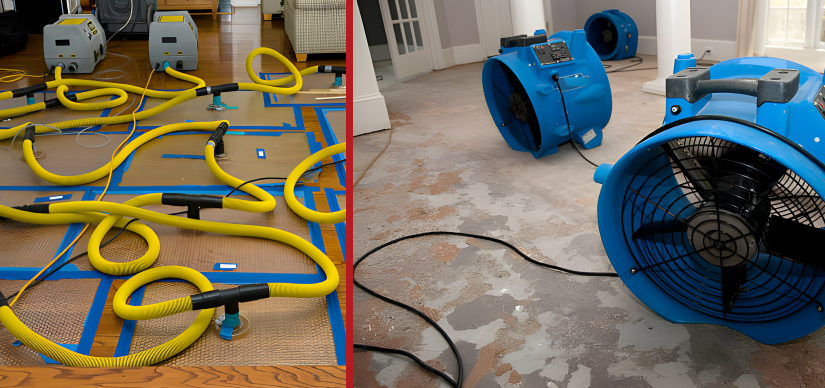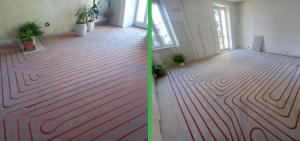San Diego Water Extraction and Dehumidification
Water messes up houses big time. It can damage walls, make mold grow and even make people sick. In San Diego, where floods or leaks can happen suddenly because of heavy rain or broken pipes, it’s super important to know how to deal with water extraction quickly. So, let’s talk about getting rid of water and drying things out, especially for folks in San Diego.
Step-by-Step Guide on Water Extraction in San Diego
In San Diego, where there’s the ocean nearby and sometimes the ground gets wet, it’s even more important to use the right tools to get rid of water. If you leave water sitting around, it can cause a lot of damage, like making things moldy or rotting wood.
Moving forward, we will discuss common signs, water extraction techniques, the extraction process and factors affecting the same.
Common Signs of Emergency Water Extraction
- 1. Absence of Standing Water:One of the most obvious signs of water extraction is the absence of standing water. If you had a water problem but now the floors are dry, extraction has likely taken place.
- 2. Humidity Reduction:After water extraction, you may notice a reduction in humidity levels indoors. The air may feel less damp and surfaces may start to dry out.
- 3. Noise from Equipment:During the water extraction process, professionals use equipment like pumps, vacuums, dehumidifiers and air movers. If you hear the sound of these machines running, it’s a sign that extraction is underway.
- 4. Visible Drying Equipment:You may see visible drying equipment, such as dehumidifiers and air movers, placed strategically throughout the affected area. These devices help speed up the drying process and are a clear indicator of ongoing water extraction efforts.
- 5. Monitoring by Professionals:If professionals are involved in the water extraction process, they may periodically monitor the area to assess progress and make adjustments as needed. Their presence and actions indicate ongoing water efforts.
- 6. Improvement in Air Quality:As the drying process progresses, you may notice an improvement in indoor air quality. Stale, musty odors associated with dampness and mold may start to dissipate, indicating successful extraction and drying.
- 7. Visible Restoration Work:After water extraction, restoration work may begin to repair any damage caused by the water. This could include replacing damaged drywall, flooring, or other materials, as well as repainting or refinishing surfaces
- 8. Prevention of Mold Growth:Prompt and effective water extraction helps prevent mold growth, so if you don’t see any signs of mold developing after a water incident, extraction is likely successful.
Water Extraction Techniques
- Water Extraction Pumps:These are like super-powered vacuums that suck up water. They’re great for getting rid of lots of water quickly. Imagine a giant straw that sucks up water from your floors.
- Wet Vacuums:Think of these as regular vacuums but for water. They’re handy for smaller areas or places where pumps can’t reach easily. They work by sucking up water into a tank, just like a regular vacuum sucks up dirt.
- Extraction Mats:These are big, absorbent towels that soak up water from floors. They’re good for smaller amounts of water or hard-to-reach places. You lay them down, and they soak up the water like a sponge.
Water Extraction Process Step by Step
- 1. Assessment:One of the most obvious signs of water extraction is the When the professionals arrive at your property, the first thing they do is assess the situation. They look at how much water there is, where it’s coming from, and how much damage it’s caused. This assessment helps them figure out the best way to tackle the problem.
- 2. Identification of Water Source:Finding out where the water is coming from is crucial because it helps stop more water from getting in. Whether it’s a burst pipe, a leaking roof, or flooding from outside, knowing the source helps prevent further damage.
- 3. Tailored Extraction Plan:Once they understand the situation, the experts come up with a plan to get rid of the water. This plan is tailored to your specific situation and may involve different techniques and tools depending on how much water there is and where it’s located.
- 4. Swift Removal of Standing Water:Using powerful pumps and vacuums, the professionals start getting rid of the water. They work quickly to remove as much standing water as possible to prevent further damage to your property. This step is crucial because the longer water sits, the more damage it can cause.
- 5. Thorough Drying:After removing the standing water, the next step is to dry out the area completely. It is done using specialized equipment like dehumidifiers and air movers. Dehumidifiers help remove excess moisture from the air, while air movers circulate air and speed up the drying process.
- 6. Restoration:Once everything is dry, the restoration process begins. It may involve repairing damaged walls, floors, or ceilings, as well as replacing any items that couldn’t be saved. The goal is to return your property to its pre-water damage condition as quickly as possible.
Factors Affecting Water Extraction Cost
- The cost of water extraction services in San Diego can vary depending on several factors, including the extent of the damage, the size of the affected area, and the type of water involved (clean water, gray water, or black water).
- Additionally, factors like accessibility, equipment required, and restoration efforts can influence the overall cost.
- It’s advisable to obtain detailed estimates from reputable restoration companies to understand the expenses involved.
An Ultimate Guide to Dehumidification for Water Extraction Near Me
Dehumidification is the process of reducing humidity levels in the air. In San Diego, where the climate is semi-arid Mediterranean, humidity levels can fluctuate, especially during certain times of the year.
High humidity levels can worsen water damage by slowing down the drying process and creating conditions conducive to mold growth. Dehumidifiers are devices specifically designed to extract moisture from the air, thereby lowering humidity levels and creating a healthier indoor environment.
Role of Dehumidification in Water Damage Restoration
- Preventing Mold Growth: By removing excess moisture from the air, dehumidifiers help prevent mold growth. Mold can start to develop within 24 to 48 hours after water damage occurs, so it’s crucial to control humidity levels promptly.
- Speeding Up Drying Process: Dehumidifiers work alongside other drying equipment, such as air movers and heaters, to accelerate the drying process. By reducing humidity levels, dehumidifiers help evaporate moisture from wet materials more efficiently, expediting the restoration process.
- Protecting Indoor Air Quality: High humidity levels can compromise indoor air quality by promoting the growth of mold and mildew, as well as attracting pests like dust mites. Dehumidifiers help maintain healthy indoor air by removing excess moisture and reducing the risk of allergens and pollutants.
- Preventing Secondary Damage: Prolonged exposure to high humidity can lead to secondary damage, such as warped wood, peeling paint, and musty odors. Dehumidification mitigates the risk of secondary damage by maintaining optimal humidity levels during drying.
Emergency Water Extraction Services
- 1.24/7 Availability: Companies specializing in water damage restoration understand that water emergencies can occur at any time, day or night. As such, they offer round-the-clock emergency response to ensure prompt assistance whenever disaster strikes.
- 2. Rapid Response: Upon receiving a distress call, emergency water extraction teams mobilize quickly to the affected location. Time is of the essence in water damage situations, and a swift response can help mitigate losses and prevent secondary damage.
- 3. Expertise and Equipment: Emergency water extraction teams are equipped with specialized knowledge, training, and state-of-the-art equipment to handle water emergencies efficiently. They utilize powerful pumps, extractors, and drying equipment to remove standing water, dry out the affected area, and restore the property to its pre-damage condition.
- 4. Thorough Assessment: Before initiating the extraction process, professionals conduct a thorough assessment of the damage. It includes identifying the source of water intrusion, evaluating the extent of damage, and devising a tailored plan for extraction and mitigation.
- 5. Mitigation and Restoration: In addition to water extraction, emergency services may include mitigation measures to prevent further damage, such as boarding up windows, tarping roofs, or initiating mold remediation. Once the immediate threat is addressed, restoration efforts begin to repair and rebuild the damaged areas.
Choosing a Water Extraction Service Near You
When selecting an extraction service in San Diego, it’s essential to choose a reputable and experienced company with a proven track record in water damage restoration. Look for certifications, such as IICRC certification, which ensures industry-standard practices like All Star Plumbing Service company.
Additionally, consider reading reviews, asking for referrals, and verifying licenses and insurance coverage before making a decision.
Conclusion
Water damage can be devastating, but with prompt and effective extraction and dehumidification, you can mitigate losses and restore your property to its pre-loss condition. In San Diego, where water-related emergencies are a potential threat, being prepared and having access to reliable restoration services is key.
By understanding the water extraction process, utilizing advanced techniques, and choosing the right professionals, you can safeguard your property and ensure a swift recovery from water damage.







